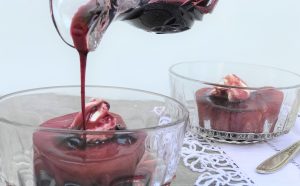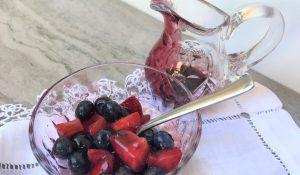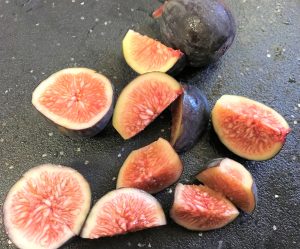
There might not be many things finer than peaches and nectarines poached, soaked and otherwise doused in some of the best Italian wines and liqueurs. Now that we are in the thick of summertime, mid-August, the stone fruits are out there and won’t last much longer. So bring on the Chianti, Marsala and Moscato.
First of all, let’s review these spirits. In my humble opinion, the creation of such fascinating beverages further proves that Italy has a brilliant cuisine. Take Marsala for example. Named after the port city in Sicily and the terroir that produces its grapes, this wine personifies the mysterious and captivating atmosphere of the place. Fortified with brandy and made with either white or red grapes from the region, Marsala comes in three levels of sweetness and several ranges of aging, with Vergine and Soleras Riserva, aged at least ten years. Ah yes, something else that gets better with age!
Next, we have Chianti, the famous Tuscan town north of Florence, which produces rich, red wine like no other. The dry, earthy aroma brings forth images of the bulbous bottle wrapped in the traditional fiasco basket. To this day, I love drinking a little glass of Chianti out of a juice glass. It tastes like heaven and smells like fresh soil, cherries and roses.
Most noteworthy: Three levels of Chianti
In order to receive the official Chianti name, the wine must come from grapes grown in the region between Florence and Siena and must be made from either 75 – 80% Sangiovese. Depending on your budget, choose Chianti or Chianti Classico, which is a bit more pricey and made from the best vineyards in the area. For the top choice, Classico Riserva, is aged for a minimum of 2 years and is a bit more of a financial investment. For more of the particulars about production of this great old world wine, look at the official site.

Are we having fun yet? Our last and oldest guest is moscat blanc which comes in about 200 grape varieties and is much, much older than Methuselah. In Italy, it is commonly known as Moscato di Asti (semi-sparkling) and Asti Spumante (sparkling). Because this varietal has been around for so many centuries, Moscato can be found in France, Spain, Portugal, Australia and California. It is the perfect dessert wine because it is light, low in calories and has a low alcohol content compared to other wines. If that is not enough, Moscato surged in popularity when it became a favorite among rappers. Who knew?
Gallo Brothers in the jug
There was never a supper in my grandparents’ house that did not include a glass of red wine served from a big Gallo Brothers jug. My grandfather always filled two juice glasses, one for him and one for my grandmother. Brothers Ernest and Julio Gallo, grandsons of Italian immigrants from Piedmont, started their wine business in Modesto, California in 1933. They produced on a massive scale and for a time became one of the most successful wineries in the country.
None of that really matters now. I don’t know which grapes the Gallo Brothers used in that jug, but, as a result, whenever I smell Chianti wine, it brings me right back to my grandparents’ kitchen table.
And now… for the recipes!
Highlighting summer Stone Fruit: In the Rose Family
Summer Peaches Poached in Chianti

Lavish dessert for a summer night.
Ingredients
- 1 lb. or about 4 medium peaches (You can use any stone fruit)
- 1 cup Chianti or dry red wine
- 1/4 cup sugar
- 4 inches fresh lemon peel
- optional: a few spoonfuls of Mascarpone
Directions
- Wash peaches, cut in half and remove pit. You may either leave the skin on or take it off. Personally, I like to leave the skin on. The peaches hold together better and many of the nutrients and fiber are retained. However, if you must- to remove skin, place peaches in boiling water for 30 seconds. Remove with a slotted spoon, run under cold water and peel off the skin.
- In a medium saucepan, bring wine and sugar to a boil and then add lemon peel. Simmer gently for 10 minutes, uncovered.
- Add the peach halves and continue to simmer gently for 5 – 10 minutes until the peaches are just fork tender. The timing depends on the ripeness of the fruit.
- Carefully remove the peaches with a slotted spoon and continue simmering the sauce, uncovered for about 10 minutes to reduce the sauce to about 3/4 cup. Remove from heat and put in a jar or glass container.
- Bring peaches and syrup to room temperature and refrigerate for at least an hour. To serve: place 2 peach halves on a pretty dish and drizzle with Chianti syrup. Enjoy with biscotti.
- For a special touch: top each peach half with a dollop of Mascarpone, sweet Italian cheese and a sprig of fresh mint. Extra sauce? This red wine Chianti sauce is fabulous on any fruit. Here it is featured on blueberries and strawberries for a stunning dessert.

Peaches marinated in Moscato

A fabulous dessert for a summer afternoon.
Ingredients
- 4 large peaches or nectarines, pitted and sliced in 8 wedges each (again, any stone fruit will do)
- 6 tablespoons sugar
- 1 cup Moscato d’Asti or other dry white wine
- several sprigs of fresh mint
- optional, a few healthy spoonfuls of Mascarpone
Directions
- Arrange a layer of peach slices in the bottom of a glass dish. Sprinkle with sugar and then add another layer of peaches. Continue layering until you have used all the sugar and peaches. Cover and refrigerate for 2 hours to let the sugar bring out the fruit juices and flavors.
- Remove from the fridge and pour in the wine. Make sure the fruit is just about covered with wine and give everything a gentle stir. Cover and return to the fridge for 4-6 hours.
- To serve, spoon peaches into wine glasses or pretty serving bowls and then pour wine syrup on top. Place a sprig of fresh mint in the center. If feeling adventurous, add a dollop of Mascarpone.
Stay tuned…Next week we will use Marsala to make classic Zabaglioni served over cherries plums and figs.
Yum! See you next week. Ciao!

As usual the description and pictures make my mouth water!
Hi Mr. Goodman,
Excellent! That really is my ultimate goal.
Love it!!!
Love the desserts & history I’m Very familiar with!
Look’n forward to the zabaglione next week! 😋